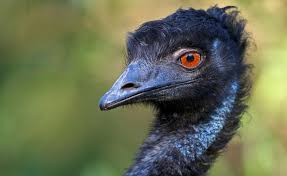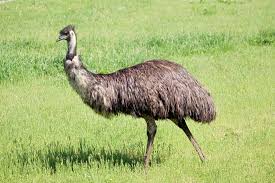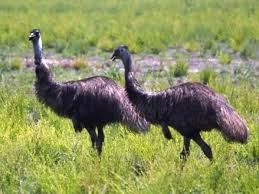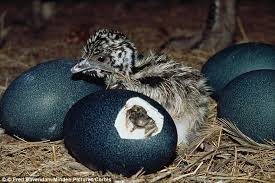The emu is the second-largest living bird by height, after its ratite relative, the ostrich. It is endemic to
Australia where it is the largest native bird and the only extant member of the genus Dromaius. The emu's
range covers most of mainland Australia, but the Tasmanian emu and King Island emu subspecies became extinct
after the European settlement of Australia in 1788. The bird is sufficiently common for it to be rated as a
least-concern species by the International Union for Conservation of Nature.
Emus are soft-feathered, brown, flightless birds with long necks and legs, and can reach up to 1.9 metres
(6.2 ft) in height. Emus can travel great distances, and when necessary can sprint at 50 km/h (31 mph); they
forage for a variety of plants and insects, but have been known to go for weeks without eating. They drink
infrequently, but take in copious amounts of water when the opportunity arises.
Breeding takes place in May and June, and fighting among females for a mate is common. Females can mate
several times and lay several clutches of eggs in one season. The male does the incubation; during this
process he hardly eats or drinks and loses a significant amount of weight. The eggs hatch after around
eight weeks, and the young are nurtured by their fathers. They reach full size after around six months, but
can remain as a family unit until the next breeding season. The emu is an important cultural icon of
Australia, appearing on the coat of arms and various coins. The bird features prominently in Indigenous
Australian mythology.
Description
The emu is the second largest bird in the world, only being exceeded in size by the ostrich; the largest
individuals can reach up to 150 to 190 cm (59 to 75 in) in height. Measured from the bill to the tail, emus
range in length from 139 to 164 cm (55 to 65 in), with males averaging 148.5 cm (58.5 in) and females
averaging 156.8 cm (61.7 in). Emus weigh between 18 and 60 kg (40 and 132 lb), with an average of 31.5 and
37 kg (69 and 82 lb) in males and females, respectively. Females are usually slightly larger than males and
are substantially wider across the rump.
Although flightless, emus have vestigial wings, the wing chord measuring around 20 cm (8 in), and each wing
having a small claw at the tip. Emus flap their wings when running, perhaps as a means of stabilising
themselves when moving fast. They have long necks and legs, and can run at speeds of 48 km/h (30 mph) due to
their highly specialised pelvic limb musculature. Their feet have only three toes and a similarly reduced
number of bones and associated foot muscles; emus are the only birds with gastrocnemius muscles in the back
of the lower legs. The pelvic limb muscles of emus contribute a similar proportion of the total body mass
as do the flight muscles of flying birds. When walking, the emu takes strides of about 100 cm (3.3 ft), but
at full gallop, a stride can be as long as 275 cm (9 ft). Its legs are devoid of feathers and underneath its f
eet are thick, cushioned pads. Like the cassowary, the emu has sharp claws on its toes which are its major
defensive attribute, and are used in combat to inflict wounds on opponents by kicking. The toe and claw
total 15 cm (6 in) in length. The bill is quite small, measuring 5.6 to 6.7 cm (2.2 to 2.6 in), and is
soft, being adapted for grazing. Emus have good eyesight and hearing, which allows them to detect threats
at some distance.
The neck of the emu is pale blue and shows through its sparse feathers. They have grey-brown plumage of
shaggy appearance; the shafts and the tips of the feathers are black. Solar radiation is absorbed by the
tips, and the inner plumage insulates the skin. This prevents the birds from overheating, allowing them to
be active during the heat of the day. A unique feature of the emu feather is the double rachis emerging
from a single shaft. Both of the rachis have the same length, and the texture is variable; the area near the skin is rather furry, but the more distant ends resemble grass.[7] The sexes are similar in appearance,[40] although the male's penis can become visible when he urinates and defecates.[41] The plumage varies in colour due to environmental factors, giving the bird a natural camouflage. Feathers of emus in more arid areas with red soils have a rufous tint while birds residing in damp conditions are generally darker in hue.[33] The juvenile plumage develops at about three months and is blackish finely barred with brown, with the head and neck being especially dark. The facial feathers gradually thin to expose the bluish skin. The adult plumage has developed by about fifteen months.[29]
The eyes of an emu are protected by nictitating membranes. These are translucent, secondary eyelids that move
horizontally from the inside edge of the eye to the outside edge. They function as visors to protect the
eyes from the dust that is prevalent in windy arid region.] Emus have a tracheal pouch, which becomes more
prominent during the mating season. At more than 30 cm (12 in) in length, it is quite spacious; it has a
thin wall, and an opening just 8 centimetres (3 in) long.
Distribution and habitat
Once common on the east coast of Australia, emus are now uncommon there; by contrast, the development of
agriculture and the provision of water for stock in the interior of the continent have increased the range
of the emu in arid regions. Emus live in various habitats across Australia both inland and near the coast.
They are most common in areas of sclerophyll forest and savannah woodland, and least common in heavily
populated districts and arid areas with annual precipitation of less than 600 millimetres (24 in). Emus
predominately travel in pairs, and while they can form large flocks, this is an atypical social behaviour
that arises from the common need to move towards a new food source. Emus have been shown to travel long
distances to reach abundant feeding areas. In Western Australia, emu movements follow a distinct seasonal
pattern north in summer and south in winter. On the east coast their wanderings seem to be more random and
do not appear to follow a set pattern.
Behaviour
Emus are diurnal birds and spend their day foraging, preening their plumage with their beak, dust bathing
and resting. They are generally gregarious birds apart from the breeding season, and while some forage,
others remain vigilant to their mutual benefit. They are able to swim when necessary, although they rarely
do so unless the area is flooded or they need to cross a river.
Emus begin to settle down at sunset and sleep during the night. They do not sleep continuously but rouse
themselves several times during the night. When falling asleep, emus first squat on their tarsi and enter a
drowsy state during which they are alert enough to react to stimuli and quickly return to a fully awakened
state if disturbed. As they fall into deeper sleep, their neck droops closer to the body and the eyelids
begin to close. If there are no disturbances, they fall into a deeper sleep after about twenty minutes.
During this phase, the body is gradually lowered until it is touching the ground with the legs folded
underneath. The beak is turned down so that the whole neck becomes S-shaped and folded onto itself. The
feathers direct any rain downwards onto the ground. It has been suggested that the sleeping position is a
type of camouflage, mimicking a small mound. Emus typically awake from deep sleep once every ninety minutes
or so and stand upright to feed briefly or defecate. This period of wakefulness lasts for ten to twenty
minutes, after which they return to slumber. Overall, an emu sleeps for around seven hours in each
twenty-four-hour period. Young emus usually sleep with their neck flat and stretched forward along the
ground surface.
The vocalisations of emus mostly consist of various booming and grunting sounds. The booming is created by
the inflatable throat pouch; the pitch can be regulated by the bird and depends on the size of the aperture.
Most of the booming is done by females; it is part of the courtship ritual, is used to announce the holding
of territory and is issued as a threat to rivals. A high-intensity boom is audible 2 kilometres (1.2 mi)
away, while a low, more resonant call, produced during the breeding season, may at first attract mates
and peaks while the male is incubating the eggs. Most of the grunting is done by males. It is used
principally during the breeding season in territorial defence, as a threat to other males, during
courtship and while the female is laying. Both sexes sometimes boom or grunt during threat displays or on
encountering strange objects.
On very hot days, emus pant to maintain their body temperature, their lungs work as evaporative coolers and,
unlike some other species, the resulting low levels of carbon dioxide in the blood do not appear to cause
alkalosis. For normal breathing in cooler weather, they have large, multifolded nasal passages. Cool air
warms as it passes through into the lungs, extracting heat from the nasal region. On exhalation, the emu's
cold nasal turbinates condense moisture back out of the air and absorb it for reuse. As with other ratites,
the emu has great homeothermic ability, and can maintain this status from −5 to 45 °C (23 to 113 °F). The
thermoneutral zone of emus lies between 10 and 30 °C (50 and 86 °F).
As with other ratites, emus have a relatively low basal metabolic rate compared to other types of birds.
At −5 °C (23 °F), the metabolic rate of an emu sitting down is about 60% of that when standing, partly
because the lack of feathers under the stomach leads to a higher rate of heat loss when standing from the
exposed underbelly.
Diet
Emus forage in a diurnal pattern and eat a variety of native and introduced plant species. The diet depends
on seasonal availability with such plants as Acacia, Casuarina and grasses being favoured. They also eat
insects and other arthropods, including grasshoppers and crickets, beetles, cockroaches, ladybirds, Bogong
and cotton-boll moth larvae, ants, spiders and millipedes. This provides a large part of their protein
requirements. In Western Australia, food preferences have been observed in travelling emus; they eat seeds
from Acacia aneura until the rains arrive, after which they move on to fresh grass shoots and caterpillars;
in winter they feed on the leaves and pods of Cassia and in spring, they consume grasshoppers and the fruit
of Santalum acuminatum, a sort of quandong. They are also known to feed on wheat, and any fruit or other
crops that they can access, easily climbing over high fences if necessary. Emus serve as an important agent
for the dispersal of large viable seeds, which contributes to floral biodiversity. One undesirable effect
of this occurred in Queensland in the early twentieth century when emus fed on the fruit of prickly pears
in the outback. They defecated the seeds in various places as they moved around, and this led to a series
of campaigns to hunt emus and prevent the seeds of the invasive cactus being spread. The cacti were
eventually controlled by an introduced moth (Cactoblastis cactorum ) whose larvae fed on the plant, one
of the earliest examples of biological control.
Small stones are swallowed to assist in the grinding up and digestion of the plant material. Individual
stones may weigh 45 g (1.6 oz) and the birds may have as much as 745 g (1.642 lb) in their gizzards at
one time. They also eat charcoal, although the reason for this is unclear. Captive emus have been known
to eat shards of glass, marbles, car keys, jewellery, and nuts and bolts.
Emus drink infrequently, but ingest large amounts when the opportunity arises. They typically drink once a
day, first inspecting the water body and surrounding area in groups before kneeling down at the edge to
drink. They prefer being on firm ground while drinking, rather than on rocks or mud, but if they sense
danger, they often stand rather than kneel. If not disturbed, they may drink continuously for ten minutes.
Due to the scarcity of water sources, emus are sometimes forced to go without water for several days. In the
wild, they often share water holes with kangaroos, other birds and animals; they are wary and tend to wait
for the other animals to leave before they quench their thirst.
Breeding
Emus form breeding pairs during the summer months of December and January, and may remain together for about
five months. During this time, they stay in an area a few kilometres in diameter and it is believed they
find and defend territory within this area. Both males and females put on weight during the breeding season,
with the female becoming slightly heavier at between 45 and 58 kg (99 and 128 lb). Mating usually takes
place between April and June; the exact timing is determined by the climate as the birds nest during the
coolest part of the year. During the breeding season, males experience hormonal changes, including an
increase in luteinizing hormone and testosterone levels, and their testicles double in size.
Males construct a rough nest in a semi-sheltered hollow on the ground, using bark, grass, sticks and leaves
to line it. The nest is almost always a flat surface rather than a segment of a sphere, although in cold
conditions the nest is taller, up to 7 cm (2.8 in) tall, and more spherical to provide some extra heat
retention. When other material is lacking, the bird sometimes uses a spinifex tussock a metre or so across,
despite the prickly nature of the foliage. The nest can be placed on open ground or near a shrub or rock.
The nest is usually placed in an area where the emu has a clear view of its surroundings and can detect
approaching predators.
Female emus court the males; the female's plumage darkens slightly and the small patches of bare, featherless
skin just below the eyes and near the beak turn turquoise-blue. The colour of the male's plumage remains
unchanged, although the bare patches of skin also turn light blue. When courting, females stride around,
pulling their neck back while puffing out their feathers and emitting low, monosyllabic calls that have
been compared to drum beats. This calling can occur when males are out of sight or more than 50 metres
(160 ft) away. Once the male's attention has been gained, the female circles her prospective mate at a
distance of 10 to 40 metres (30 to 130 ft). As she does this, she looks at him by turning her neck, while at
the same time keeping her rump facing towards him. If the male shows interest in the parading female, he
will move closer; the female continues the courtship by shuffling further away but continuing to circle him.
If a male is interested, he will stretch his neck and erect his feathers, then bend over and peck at the
ground. He will circle around and sidle up to the female, swaying his body and neck from side to side, and
rubbing his breast against his partner's rump. Often the female will reject his advances with aggression, but
if amenable, she signals acceptance by squatting down and raising her rump.
Females are more aggressive than males during the courtship period, often fighting for access to mates, with
fights among females accounting for more than half the aggressive interactions during this period. If females
court a male that already has a partner, the incumbent female will try to repel the competitor, usually by
chasing and kicking. These interactions can be prolonged, lasting up to five hours, especially when the
male being fought over is single and neither female has the advantage of incumbency. In these cases, the
females typically intensify their calls and displays.
The sperm from a mating is stored by the female and can suffice to fertilise about six eggs. The pair mate
every day or two, and every second or third day the female lays one of a clutch of five to fifteen very
large, thick-shelled, green eggs. The shell is around 1 mm (0.04 in) thick, but rather thinner in northern
regions according to indigenous Australians. The eggs are on average 13 cm × 9 cm (5.1 in × 3.5 in) and
weigh between 450 and 650 g (1.0 and 1.4 lb). The maternal investment in the egg is considerable, and the
proportion of yolk to albumen, at about 50%, is greater than would be predicted for a precocial egg of this
size. This probably relates to the long incubation period which means the developing chick must consume
greater resources before hatching. The first verified occurrence of genetically identical avian twins was
demonstrated in the emu. The egg surface is granulated and pale green. During the incubation period, the egg
turns dark green, although if the egg never hatches, it will turn white from the bleaching effect of the
sun.
The male becomes broody after his mate starts laying, and may begin to incubate the eggs before the clutch
is complete. From this time on, he does not eat, drink, or defecate, and stands only to turn the eggs, which
he does about ten times a day. He develops a brood patch, a bare area of wrinkled skin which is in intimate
contact with the eggs. Over the course of the eight-week incubation period, he will lose a third of his
weight and will survive on stored body fat and on any morning dew that he can reach from the nest. As with
many other Australian birds, such as the superb fairywren, infidelity is the norm for emus, despite the
initial pair bond: once the male starts brooding, the female usually wanders off, and may mate with other
males and lay in multiple nests; thus, as many as half the chicks in a brood may not be fathered by the
incubating male, or even by either parent, as emus also exhibit brood parasitism.
Some females stay and defend the nest until the chicks start hatching, but most leave the nesting area
completely to nest again; in a good season, a female emu may nest three times. If the parents stay together
during the incubation period, they will take turns standing guard over the eggs while the other drinks and
feeds within earshot. If it perceives a threat during this period, it will lie down on top of the nest and
try to blend in with the similar-looking surrounds, and suddenly stand up to confront and scare the other
party if it comes close.
Incubation takes 56 days, and the male stops incubating the eggs shortly before they hatch. The temperature
of the nest rises slightly during the eight-week period. Although the eggs are laid sequentially, they tend
to hatch within two days of one another, as the eggs that were laid later experienced higher temperatures
and developed more rapidly. During the process, the precocial emu chicks need to develop a capacity for
thermoregulation. During incubation, the embryos are kept at a constant temperature but the chicks will need
to be able to cope with varying external temperatures by the time they hatch.
Newly hatched chicks are active and can leave the nest within a few days of hatching. They stand about 12
cm (5 in) tall at first, weigh 0.5 kg (17.6 oz), and have distinctive brown and cream stripes for
camouflage, which fade after three months or so. The male guards the growing chicks for up to seven months,
teaching them how to find food. Chicks grow very quickly and are fully grown in five to six months; they
may remain with their family group for another six months or so before they split up to breed in their
second season. During their early life, the young emus are defended by their father, who adopts a
belligerent stance towards other emus, including the mother. He does this by ruffling his feathers,
emitting sharp grunts, and kicking his legs to drive off other animals. He can also bend his knees to crouch
over smaller chicks to protect them. At night, he envelops his young with his feathers. As the young emus
cannot travel far, the parents must choose an area with plentiful food in which to breed. In captivity,
emus can live for upwards of ten years.
Predation
There are few native natural predators of emus still alive. Early in its species history it may have faced
numerous terrestrial predators now extinct, including the giant lizard Megalania, the thylacine, and
possibly other carnivorous marsupials, which may explain their seemingly well-developed ability to defend
themselves from terrestrial predators. The main predator of emus today is the dingo, which was originally
introduced by Aboriginals thousands of years ago from a stock of semi-domesticated wolves. Dingoes try to
kill the emu by attacking the head. The emu typically tries to repel the dingo by jumping into the air and
kicking or stamping the dingo on its way down. The emu jumps as the dingo barely has the capacity to jump
high enough to threaten its neck, so a correctly timed leap to coincide with the dingo's lunge can keep its
head and neck out of danger.
Despite the potential prey-predator relationship, the presence of predaceous dingoes does not appear to
heavily influence emu numbers, with other natural conditions just as likely to cause mortality. Wedge-tailed
eagles are the only avian predator capable of attacking fully-grown emus, though are perhaps most likely to
take small or young specimens. The eagles attack emus by swooping downwards rapidly and at high speed and
aiming for the head and neck. In this case, the emu's jumping technique as employed against the dingo is not
useful. The birds try to target the emu in open ground so that it cannot hide behind obstacles. Under such
circumstances, the emu can only run in a chaotic manner and change directions frequently to try and evade
its attacker. Other raptors, monitor lizards, introduced red foxes, feral and domestic dogs, and feral pigs
occasionally feed on emu eggs or kill small chicks.








